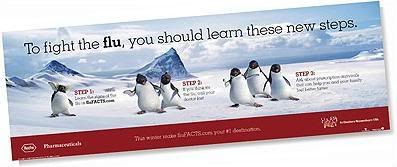
What should a pharmaceutical company do when it realises it has spent billions of dollars in R&D to come up with an anti-flu drug that is only slightly effective? Well Roche, the makers of Tamiflu, have decided the best thing to do is increase its advertising campaign for the drug.
Tamiflu is an antiviral drug that is supposed to be taken at the first signs of flu to reduce the severity and duration of symptoms. A single treatment will cost around $80 but the drug has come under fire for only being modestly effective, maybe only reducing symptoms by 1 or 2 days. Critics say the real benefit of using Tamiflu is only when there is a genuine flu epidemic such as a break out of avian flu when the drug should be circulated to minimise the transmission of the new strand of virus.
But Roche is heavily promoting Tamiflu as a drug to be used to treat the common winter flu, which frankly is misleading. The best way to treat the common flu is to get a vaccination that will prevent you from ever getting the flu, spending $80 on Tamiflu is a waste of money. Roche is promoting its drug in a largely unbranded campaign, meaning Tamiflu won’t directly be mentioned in the ads.
Roche is using playful, eye-catching advertisements in print publications and movie theaters, on television and websites, and in airports that will be filled with families. It has even sponsored an animated children’s movie that is set in Antarctica and follows a group of Penguins, ‘Happy Feet’ is released on Nov 17th and Roche ads featuring the characters are already appearing in airports.
On Roche’s Tamiflu promotion website the company suggests patients ask doctors for the antiviral, even if they are not sick. The Centers for Disease Control says “the single best way to prevent the flu” is through a vaccine, which people get before they are sick. This year, officials expect there will be plenty of flu vaccine — up to 115 million doses in the United States.